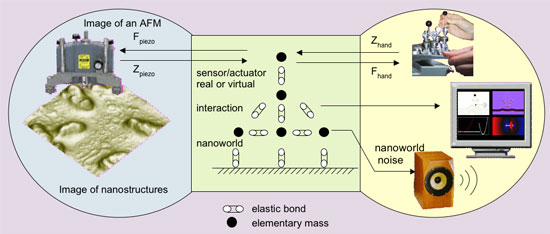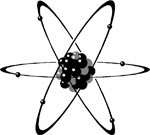| Posted: Jan 30, 2008 | |
Shaking hands with a virus - getting all touchy-feely with nanotechnology |
|
| (Nanowerk Spotlight) Our sense of touch connects us to the world around us and is an integral part of how we experience things, both physically and emotionally. In the virtual world of remote-control robots, scientific models or computer games, users generally lack tactile, or haptic (from the Greek word Haphe, pertaining to the sense of touch), feedback, which either makes delicate manipulative tasks difficult or keeps the subject purely visual and often inscrutable (an electron microscope image of a nanoscale object, for instance). The desire for natural and intuitive human machine interaction has led to the inclusion of haptics in man-machine interfaces. The user is able to control inputs to the system through hand movements and in turn receives feedback through tactile stimulation in the hands. Sophisticated, state-of-the-art haptic user-interface software is capable of adding interactive, realistic virtual touch capabilities to human-computer interactions. Among the uses are medical applications, remote vehicle or robotic control, military applications, and video games. Users are said to feel realistic weight, shape, texture, dimension, dynamics, and force effects. Applying the use of real-time virtual reality and multisensory user interface to nanoscience, scientists in France have begun to open up the otherwise only scientifically described reality of the nanoworld to a non-scientific public. | |
| While our five senses are doing a reasonably good job at representing the world around us on a macro-scale, we have no existing intuitive representation of the nanoworld, ruled by laws entirely foreign to our experience. This is where molecules mingle to create proteins; where you wouldn't recognize water as a liquid; and where minute morphological changes would reveal how much 'solid' things such as the ground or houses are constantly vibrating and moving. | |
| "A central challenge is how we can put our hands on scientifically explored parts of reality that cannot be reached by our senses and whose rules are completely foreign to our representation of reality" Dr. Joël Chevrier tells Nanowerk. "Since science is full of abstract descriptions it is hard to represent it in an easy way. But thanks to computer sciences and robotics we now have the necessary tools to use human senses to explore, in real-time, model worlds as they are described by science, or even true reality when coupling these multisensory interfaces to real nanosensors and nanoactuators." | |
| Chevrier, a professor at the Université Joseph Fourier in Grenoble, France, together with his collaborators hopes to open up a completely new field for our perception. This new 'playground' – using haptic, vision and sound interfaces – is the world we are living in; but explored at scales entirely foreign to everything we experience around us. | |
| "In the nanoworld simulacrum that we have begun to build, object identification will be based on the intrinsic physical and chemical properties of the probed entities, on their interactions with sensors, and on the final choices made in building a multisensory interface so that these objects become coherent elements of the human sphere of action and perception" says Chevrier. | |
| In other words, we might be able to touch, feel and interact with the nano-realm which otherwise is not open to our direct experience. Chevrier hopes that this will be a major step in helping non-scientists understand nanoscience and nanotechnology. The scientifically described part of our reality, much of what mathematics, physics or chemistry – and certainly nanoscience and nanotechnology – is about, usually is inaccessible to people not trained in these subjects (i.e. to most of us). Opening up this part of reality to everybody could go a long way in creating interest in science education, science jobs and help a better informed public to lead a more objective discussion on the pros and cons of nanotechnology. | |
| Rather than using the abstract descriptions and experiments of a classical science education, the French team has begun to use real-time virtual reality combined with a multisensory human-machine interface to allow the direct perception of and interaction with the nanoworld. | |
| "One way to develop this extension of the sphere where our senses are efficient can be based on nanosensors and nanoactuators " explains Chevrier. "Another approach is to use virtual environments which can bring the nanoworld to us through real-time multisensory interfaces. This can dramatically enhance the possibilities for easy exploration of remote realities foreign to our senses and can trigger a spontaneous motivation in users, similar to the one observed in videogame players." | |
| In a presentation at the 4th International Conference on Enactive Interfaces last November in Grenoble ("Implementation of perception and action at nanoscale" – pdf download 376 KB), the French team describe a 1D virtual nanomanipulator, part of the Cité des Sciences EXPO NANO in Paris, that is the first realization based on this idea. | |
| Chevrier and his team built a virtual atomic force microscope (AFM) and coupled it to an advanced haptic interface as well as a sonification and visualization system. The resulting instrument allows its user to experience contact of a surface at the nanoscale. About 10,000 people have used this demonstrator during three exhibitions in Grenoble, Paris and Geneva. | |
 |
|
| Image of the virtual machine. Left: image of a real Atomic Force Microscope (AFM); Center: elastic model of the nanoprobe, the nanoworld and interaction, based on mass and spring combination. Right: the user interface is a multisensorial platform. (Image: Sylvain Marlière, PhD thesis). | |
| A central part of this concept is not a new idea. In their paper, the researchers write that it goes back to the earliest days of experimental science: the use of a telescope by Galileo to observe the Moon and to come to the immediate conclusion that the Moon is Earth-like. As immediately emphasized by Galileo, this dramatic change in the human representation of the universe is caused by direct use of senses technically extended by an instrument and not by a posteriori rational demonstration. | |
| "Our proposal can be seen as a revival of this famous tale" says Chevrier. "There is however a major difference. Two points can illustrate the need for new approaches in implementing the nanoscale in virtual environments: 1) As nanoscale is gradually approached, continuous description no longer stands and the molecular discontinuous structure of matter is revealed. Atomic scale is a radical rupture with our common experience that is based on the objective existence of isolated continuous objects. 2) can we manage to 'see' and 'touch' an electron, a particle that has a mass and an electric charge but has no classical material spatial extension in the sense of a material sphere, although it is at the root of the stability of matter. In fact seeing and touching an electron has no intrinsic meaning. Electron-based objects can however be created and our interaction with these unusual objects defined." | |
| Almost all scientific data today is represented visually. That's why we have all these amazing electron microscope images and artists' impressions of nanoscale objects. That's also why most people can't really get a grip (literally) on scientific discoveries unless they result in a better remote control for their TV. Enriching the visual component with interactive tactile and sound aspects, and wrapping the whole thing into a virtual reality environment, will give us a much richer and more real experience of these objects. | |
| At the Center for Cognitive Ubiquitous Computing (CUbiC) at Arizona State University they have developed some pretty interesting haptic visualization schemes. Many object features are easy to invoke in human memory and are presented through tactile cueing. There are however some features that are not primary haptic features but may contribute to further knowledge of the object. Example of such features include weight of the object. At CUbiC they have developed a haptic visualization scheme for instance for the presentation of weight. In this scheme, a user is able to bounce the virtual object off an imaginary surface. When the object hits back, it generates a vibrotactile stimulation analogous to the weight of the object. | |
 |
Even if technology will one day offer us sophisticated tools to explore the nanoworld with our senses, the question is whether we will be able to really grasp it. Imagine an atom. Chances are you are seeing a Nagaoka. In 1904, a Japanese physicist named Hantaro Nagaoka created the classic atom image with planet-like electrons orbiting around a nucleus.This is the picture that many people have in mind – cute, but wrong. Reality at the atomic scale is much, much weirder: atoms are mostly empty space and the solid world we are experiencing around us is an illusion. Timothy Ferris has described this nicely in his book Coming of Age in the Milky Way |
| A bar of gold, though it looks solid, is composed almost entirely of empty space. The nucleus of each of its atoms is so small that if one atom were enlarged a million billion times, until its outer electron shell was as big as greater Los Angeles, its nucleus would still be only about the size of a compact car parked downtown. The electron shells would be zones of insubstantial lightning, each a mile or so thick, separated by many miles of space. Nor, to return to the old classical metaphor, does a cue ball strike a billiard ball. Rather, the negatively charged fields of the two balls repel each other; on the subatomic scale, the billiard balls are as spacious as galaxies, and were it not for their electrical charges they could, like galaxies, pass right through each other unscathed. | |
| So while your 'reality' tells you that you are sitting in your chair right now as you are reading this, reality at the subatomic level means that you are not really sitting in your chair – thanks to the repulsion of your and the chair's electrons you are actually floating on it at a height of a fraction of a nanometer. | |
| The point is that, even if we might have the tools one day to truly experience the nanoworld, its rules are so foreign to our human experience that we might not be able to comprehend it. | |
| In the more immediate future, advanced virtual nanomanipulators based on the French scientists' ideas could become exciting tools to explore the boundaries between the nano- and the macroscopic worlds – touching nanoscale water, shaking hands with an insect, crushing a virus between your fingers, playing nano-lego. They could also lead to a new generation of professional lab tools that allow nanoscale manipulation with precise control of tool interaction with nanobject. | |
| Of course, this first instrument built by Chevrier's team is more Galileo telescope than Hubble space observatory. But it is an interesting beginning that one day might result in virtual worlds that will allow us to go all weird at the nanoscale. | |
 By
Michael
Berger
– Michael is author of three books by the Royal Society of Chemistry:
Nano-Society: Pushing the Boundaries of Technology,
Nanotechnology: The Future is Tiny, and
Nanoengineering: The Skills and Tools Making Technology Invisible
Copyright ©
Nanowerk LLC
By
Michael
Berger
– Michael is author of three books by the Royal Society of Chemistry:
Nano-Society: Pushing the Boundaries of Technology,
Nanotechnology: The Future is Tiny, and
Nanoengineering: The Skills and Tools Making Technology Invisible
Copyright ©
Nanowerk LLC
|
|
Become a Spotlight guest author! Join our large and growing group of guest contributors. Have you just published a scientific paper or have other exciting developments to share with the nanotechnology community? Here is how to publish on nanowerk.com.
